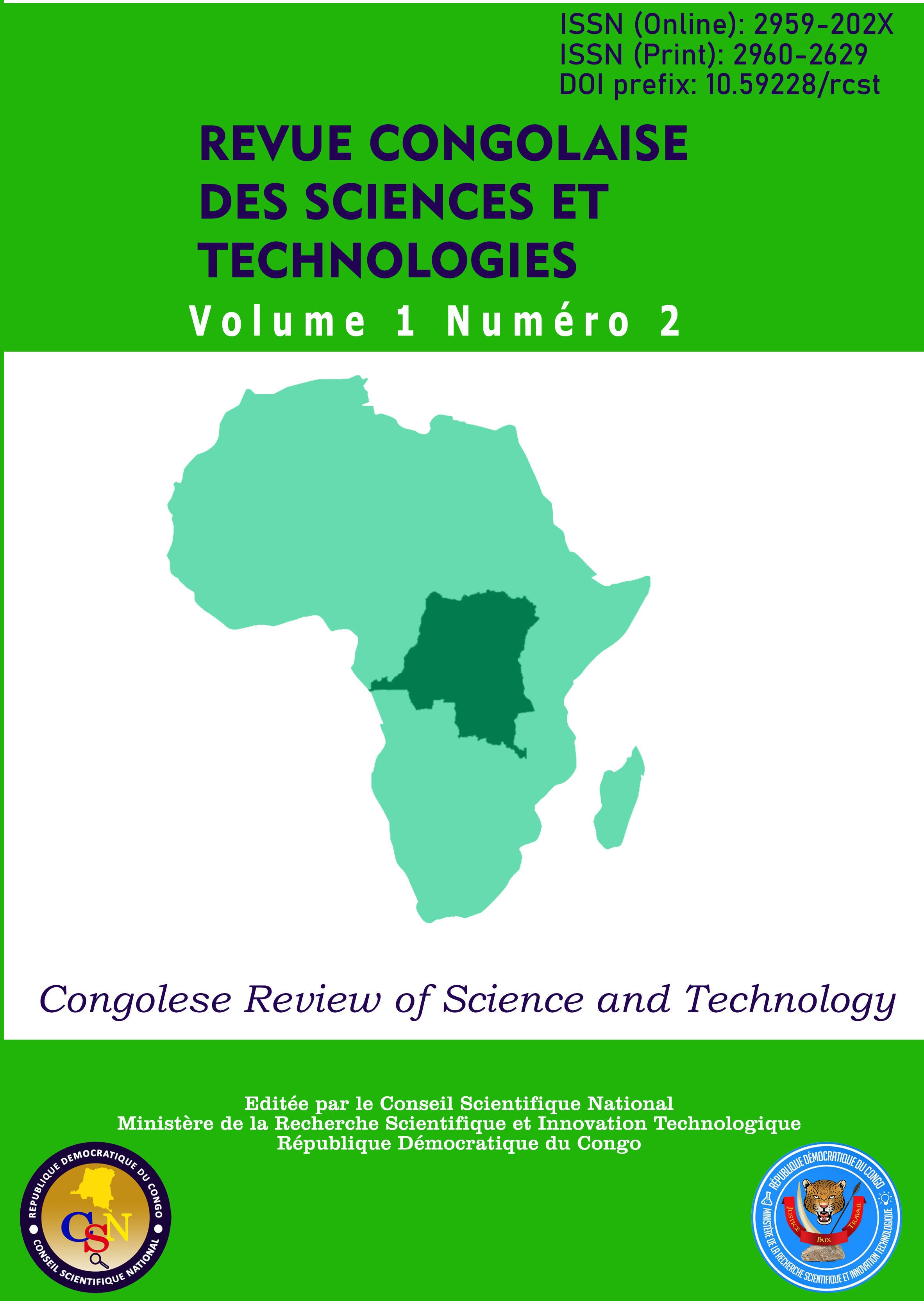Digital cartography and its contribution to the organization of the census in Democratic Republic of the Congo
Main Article Content
Abstract
Computer Aided Mapping (CAD) is based on the use of Geographic Information Systems, high resolution images and GPS
(Global Positioning System) receivers for the survey of x and y coordinates. This leads to spatial analysis of the acquired
images and the use of geo-spatial technologies, which in turn leads to the production of maps, for which standard data layers
such as the shape file of administrative boundaries, roads, cities, territories and hydrographies are required as a basis for
mapping, census and data collection activities. The automatic processing of data from upstream census mapping activities has
both advantages, the first is efficiency, which is reflected in the amount of output that can be obtained per unit of input, this
shows that more can be done at a lower cost, on the one hand, the utility advantage is reflected in the effects of programmes
benefiting from improved information, on the other. Digital census mapping is thus computer-assisted mapping, using
computer technology and taking advantage of new geo-spatial technologies to produce better maps faster and improve the
overall quality of census data than updating it.
Article Details

This work is licensed under a Creative Commons Attribution-NonCommercial-ShareAlike 4.0 International License.
References
Amar, H., Azmi, R., & Fathi, N. (2020). Introduction
au Système d’Information Géographique-SIGet prise en main du R Spatial. Paris,
Independently published.
Aschan, C., Cunt. L., & Davoine, P.A. (2019). Les
systèmes d’information géographique. Paris,
Armand colin.
ANSD. (2013). Importance de la cartographie
censitaire. Consulté le
/04/2021.www.faapa.info
Asce. (1994). The Glossary of the Mapping Sciences.
Bethesda, Maryland: American Society for
Photogrammetry and Remote Sensing, and
American Society for Civil Engineers.
Consulté le
/06/2021.https://agris.fao.org/agrissearch/search.do?recordID
Beguin, M., & Pumain, D. (1994). La représentation
des données Géographiques. Paris, Armand
Colin.Beucher, S. & Reghezza, M. (2005). La géographie :
Pourquoi ? Comment objets et démarches de
la géographie aujourd’hui. Paris, Hatier
Bradley, R. (1984). Cartographie assistée par
ordinateur pour le - mapcontext.com.
Consulté le 16/09/2016.
mapcontext.com/.../cartographie-assisteepar-ordinateur-pour-le-recense
CEA. (2007). Détermination des ensembles de
données géographiques fondamentales pour
l’Afrique: Géoinformation pour le
développement économique et social.
Document. Consulté le 20/06/2020.
ECA/ISTD/GEO/2007/02E. Addis-Abeba
Denis, A. (2014). Initiation à ArcGIS Arlon Campus
Environnement, Université de Liège. Consulté
le 24/10/ 2016.
http://orbi.ulg.ac.be/handle/2268/135775
États-Unis d’Amérique. (1978). Census Bureau
Mapping for censuses and surveys, Statistical
Training Document ISP-TR-3. Washington,
D.C.: United States Department of Commerce,
Bureau of the Census.
ESRI. (2016). Système d’information géographique.
Consulté le 15 /04/2018. www.esri.com
Geospace. (2007). Cartographie moderne pour le
recensement de la population et de l’habitat.
Consulté le 16/09/2018. www.geospace.co.za
Girard, M.C, & Girard, C.M. (2017), Traitement des
données de télédétection. Paris, Dunod.
INS. (1984). Recensement général de la population et
de l’habitat, RDC
Kasse, M. (1995). Économie du développement
références africaines. Consulté le 18/02/2020.
http://www.mkasse.com/IMG/pdf/Eco_Deve_
_tome_1.pdf,
Khadidja, H. (2021). Cartographie assistée et
système d’information géographique sig.
Consulté le 21/09/2022 http://geo.univbatna2.dz
Lesotho. (2006). Carte de base LESOTHO fabriquée
à l’aide d’image SPOT5. [Carte]. Consulté le
/09/2021. www.geospace.com
Marcello, R., & Marquez, A. (2014). Manuel de
télédétection spatiale. Consulté le 22/08/2022.
www.grss-ieee.org
MINECOFINPLAN. (2007). Recensement général de
la population et de l’habitat. Consulté le
/08/2019. www.statssa.gov.za/assddec2007/presentation/days201…/djibouti.PP
Nyandue, J. (2022). Répartition de la population de
la RDC en 1984 [Carte]. Inédit.
Poidevin, D. (2007). Manuel de cartographie.
Consulté le 24/10/2021. www.articque.com,Pornon, H. (2015). SIG : la dimension géographique
du système d'information. Paris, Dunod
Infopro,
PNUD. (2016). Rapport 2015 sur les objectifs du
millénaire pour le développement. Consulté le
/02/2017.https://www.undp.org/fr/publicati
ons/rapport-2015-sur-les-objectifs-dumillenaire-pour-le-developpement
PNUD. (2015). Rapport sur développement humain
, Consulté le 12/12/2016.
https://www.undp.org/fr/publications/rapportsur-le-developpement-humain-2014
RDC. Décret n°09/32 du 08 août 2009, portant
l’organisation du deuxième Recensement
Général de la population et de l’Habitat.
Journal officiel
RDC. (2019). Plan national stratégique de
développement
RIM. (2010). Recensement général de la population
et de l’habitat 4. Consulté le 12/06/2021.
www.economie.gv.mr
Roelandt, N. (2019). SIG : Introduction à la
géomatique et mise en place d’un système
d’information géographique. Lille, D-Booker.
UN. (2020). Manuel d’organisation et de gestion des
recensements de la population et de logement.
Consulté le 26/09/2022
.https://unstats.un.org/unsd/publication/Series
F/Series_F83Rev2fr.pdf
UN. (1998). Principes et recommandation
concernant les recensements de la population.
Consulté le
/08/2021.www.un.org/depts/unsd
UNFPA. (2020). QGIS pour la cartographie
numérique dans les recensements et les
enquêtes. Consulté le 23/07/2021.

